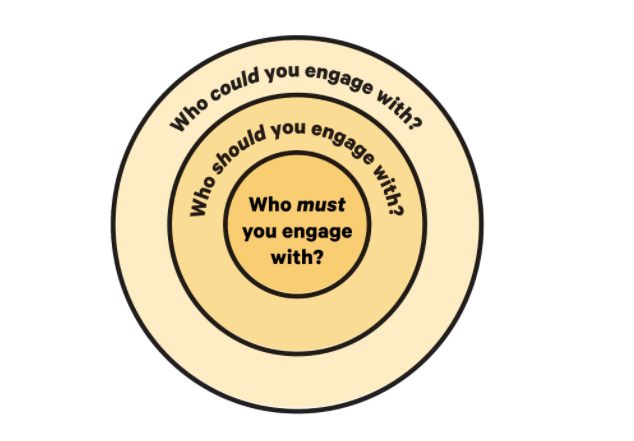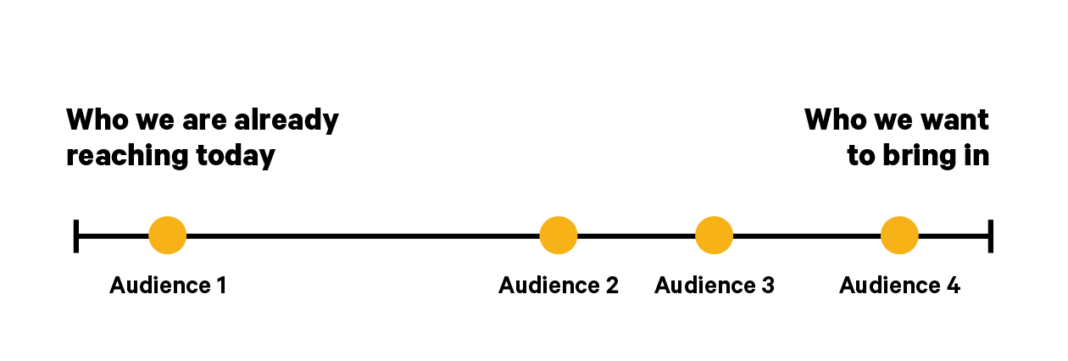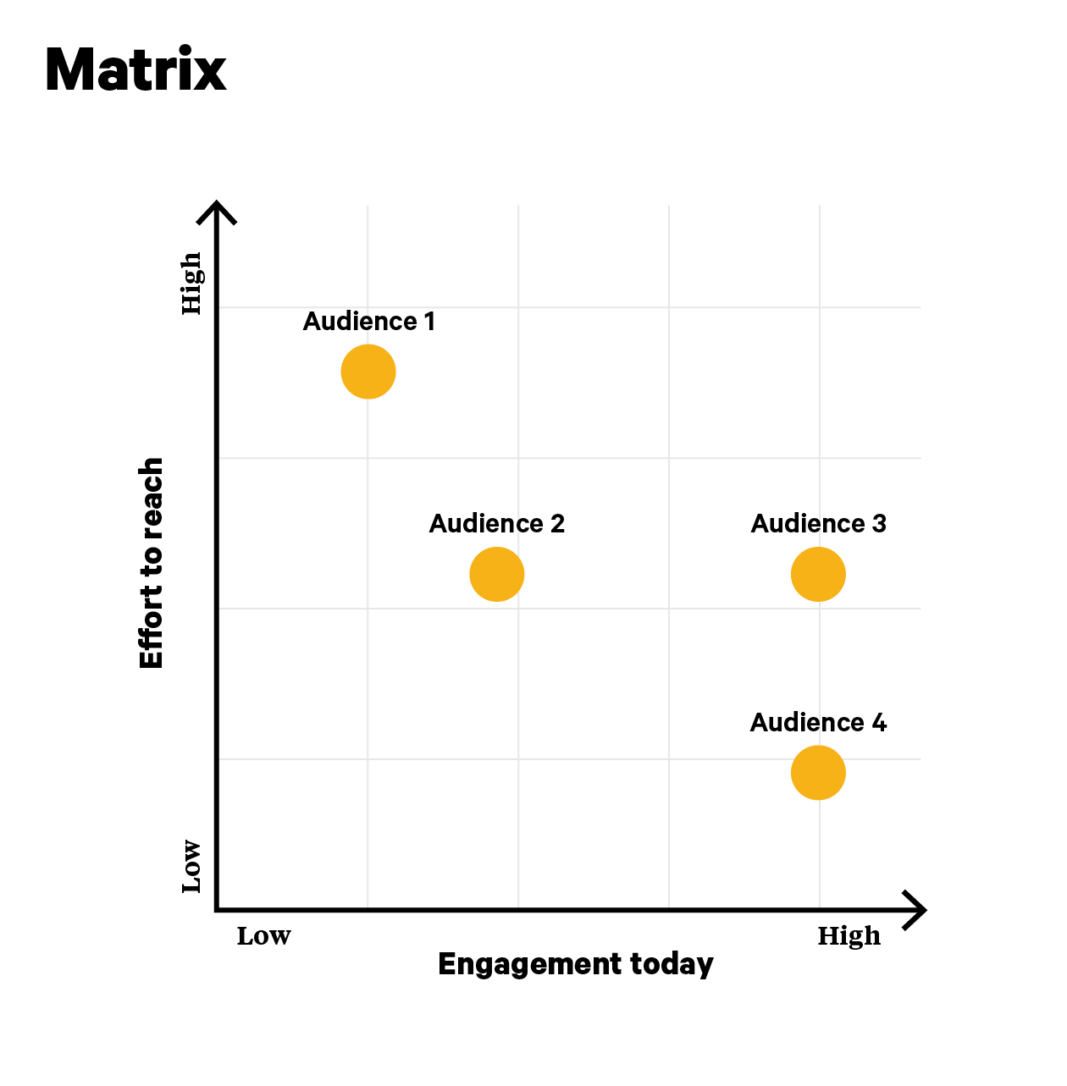Four simple frameworks to prioritize your audiences
Good communications begins with knowing who your audiences are. Seems simple, right? Sure: you can write out a long list of various groups that your organization is communicating with or wants to reach in the future… but where do you go from there?
We believe building an understanding of your audiences is a foundational part of a compelling, effective brand strategy. As organizations go through a branding process, they often realize that they have a long list of varied audience groups. For example, if you are a community organization providing free legal services, your audiences might consist of those who require your legal services, your staff and board, donors and funders, community partners, volunteers, and many others. How can you begin the process of mapping out and prioritizing these varied audiences? Where should your organization focus its limited time and resources?
Understanding your key audiences hinges on two crucial steps: identifying your key audience groups, and then prioritizing those groups to match your organizational goals. Two organizations at different stages of identifying or prioritizing might need two entirely different frameworks to approach understanding their key audiences.
We dug deep into this question at a recent brand strategy workshop with a client. The client already had a solid list of their key audiences and a primary vs. secondary approach proved too basic to help them answer the question of “what next?”—or how to approach their goal of increasing awareness across those audience groups. Our team brainstormed some alternative models by digging a little deeper into the following prompts:
- Reflect on today’s status quo: Who are the groups we already do a good job reaching? Who are the groups we need to deepen emerging relationships with? Who do we not currently reach well?
- Gauge by capacity: Who are the groups we currently have the capacity (time, money, expertise) to reach? Who can we grow into the capacity to reach?
- Think in terms of actions: Who are the groups that must take action with us in order to make strides on our mission?
Primary vs. secondary

The primary vs. secondary framework of classifying your audiences is well-known in the marketing and communications world and is a great place to start, especially if mapping out your audiences is a newer undertaking. Your primary audiences are those that you must communicate with to advance your mission or foundational goals as an organization, while your secondary audiences are those “nice-to–haves”—those who are affected by your work and who you could communicate with. Start by listing out all of your audiences, and then asking yourself which ones fall into the primary vs. secondary (and tertiary, if needed!) categories.
Pros
+ Simple, easy starting point
+ Great for organizations just starting out
Cons
− Does not allow for understanding differences between audiences within a category
− Does not capture nuance of organizational goals
Bullseye

This framework, which consists of concentric circles that look like a bullseye, is a way of mapping out your audiences and comes from The Nonprofit Communications Engine: A Leader’s Guide to Managing Mission-driven Marketing and Communications, published by our founder Sarah Durham. It builds on the previous idea of primary vs. secondary:
“At the center of the diagram are the people your organization must connect and engage with. The next ring are the people your organization should connect and engage with. The final layer are the people you might connect and engage with. The outer rings are useful to connect with, while the inner rings are essential to advance your organization’s mission. As you’re making decisions, something like this helps you understand where you should spend your time and budget.”
Pros
+ Simple, easy starting point
+ Unlike primary vs. secondary, gives you prompts to guide your key audiences with
+ Bullseye visualization helps frame exercise less around importance level or ranking, but rather as groups that build upon each other
Cons
– Definition between secondary and tertiary groups may be difficult to identify
– Does not capture nuance of organizational goals
Spectrum

This framework helps us to place our audiences on a spectrum based around a goal, which could be focused on anything from engagement to capacity. This is a great visualization exercise to do with a team, and can help to prioritize or deprioritize certain audiences as you think about next steps in your communications plan and where you should focus your outreach efforts.
You may also use this framework in conjunction with a primary vs. secondary framing, where you use the spectrum as a next step of organizing your primary audiences according to organizational goals once you have finished identifying them.
Pros
+ Dynamic
+ Helps strategize audiences according to goals on axes
Cons
– Assumes that all audiences are key audiences
– Does not take into account organizational capacity or resources

A matrix builds upon the spectrum by adding another dimension on the y-axis. This provides a fuller visualization of how to prioritize your audiences. In the example above, we start with an x-axis of “engagement today” but we also layer in “effort to engage” as a dimension—the capacity or resources that would need to be tapped to reach these folks. As an organizational exercise, this is a great way to map out which key audiences might be aspirational (top left corner) and which are safer and more familiar (bottom right), as well as those that lie in between and could be further clarified.
Pros
+ Dynamic
+ Takes into account organizational capacity and resources
+ Great for an organization that is trying to actively grow certain audiences
Cons
– Assumes that all audiences are key audiences
– May be too complex for an organization just beginning to build out their understanding of their audiences
As you might be able to tell, all these frameworks we’ve introduced simply build upon each other to tackle increasing levels of complexity in an organization’s need to understand its audiences. There are no right or wrong ways to think about audiences! Rather, you might ask yourself—how do these frameworks fit according to where your organization lies today? How would these be helpful as a tool for your team? Is there a more helpful visualization that you can think of that isn’t included here? If you’re just beginning to think about your audiences as an organization, identifying who might be primary vs. secondary in relation to your goals may be more than enough to get started. If you already know who your audiences are, and you’re looking to grow your engagement and don’t know where to begin, you may want to use more of a spectrum or matrix framework.
As for next steps: identifying and prioritizing your audiences is only the first step in building an audience-centric approach to communications. We often suggest fleshing out your organization’s understanding of these audience groups by digging deeper with the following questions:
- Why is this audience group important for us to communicate to?
- What are they looking for that we can offer?
- What do we hope they will think or feel about us?
- What actions do we want them to take?
You may also want to support your findings through qualitative and quantitative research methods. By deepening your understanding of your key audiences, you’ll be able to make better decisions in your overall communications strategy. You’ll be able to more deeply engage key groups as you build out campaigns and speak more authentically to those groups’ needs, motivating them to take action. We at Big Duck love to think about the complexity of audiences and how to take our clients’ understanding of their audiences to the next level. If you’re looking for a partner to discuss further, drop us a line!





